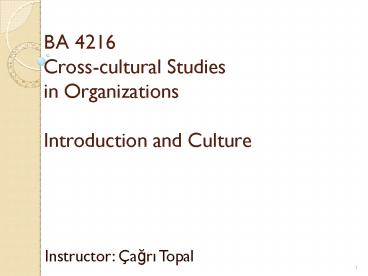BA 4216 Cross-cultural Studies in Organizations Introduction and Culture - PowerPoint PPT Presentation
1 / 22
Title:
BA 4216 Cross-cultural Studies in Organizations Introduction and Culture
Description:
BA 4216 Cross-cultural Studies in Organizations Introduction and Culture Instructor: a r Topal * Why take this course Culture as shaping managerial and ... – PowerPoint PPT presentation
Number of Views:276
Avg rating:3.0/5.0
Title: BA 4216 Cross-cultural Studies in Organizations Introduction and Culture
1
BA 4216Cross-cultural Studiesin
OrganizationsIntroduction and Culture
- Instructor Çagri Topal
2
Why take this course
- Culture as shaping managerial and organizational
practices - Cultural diversity based on differences in
education, occupation, hometown, social class,
and gender
3
General objective
- Creating cultural awareness
4
Specific Objectives
- Understand the concepts and theories of culture
as relevant to management - Apply theoretical concepts into cross-cultural
management settings - Develop critical thinking on the relation of
culture to managerial theory and practice
5
Readings
- Mixed readings from relevant textbooks
- Martin J. Gannon, Understanding Global
Cultures, 3rd and 4th editions - Textbooks on cross-cultural management available
from the library - Short cases to be distributed in class
6
Assessment-1
- Midterm 1 20
- Midterm 2 20
- Case quizzes 30
- Case presentation and report 15
- Group participation 10
- Individual participation 10
- Total 105
7
Assessment-2 IMPORTANT
- Grades and notes are final and not subject to
change. - No individual request for additional study for
raising a grade will be accepted. - No non-academic criteria such as that you are
working outside, that this is your last semester,
and that this is your only course will be
considered in grading.
8
Lecture and discussion
- Key points and examples by the instructor
- Discussion in the groups of two or three or four
students - General class discussion
- Your own questions and critiques
9
Midterms
- Two exams
- Closed-book and closed-notes
- Focus on the points emphasized in class
- Multiple-choice, fill-in-the-blank, true-false,
short- and long-answer questions - No final exam and thus no final make-up exam
10
Cases and presentations
- Ten cases
- Quiz for each case
- Each presented by a group of three or four
students - 35-40 minutes for the presentation and 15-20
minutes for the discussion
11
Case report
- Report only on the case presented-3 pages
- Not the analysis of the case
- Explanation of the preparation process of the
group - Group grade 1 point penalty for each day of late
submission - Form your groups
- Go to this page and select a case
http//old.ba.metu.edu.tr/user/ctopal/ba4216.html - Typed in appropriate format (see the syllabus)
12
Attendance and participation
- Participation essential
- Bring questions
- Provide new insights based on theories
- Share your relevant personal experiences
- Be critical of the course material
13
Civility
- Be in class on time
- Turn your cellular phones off
- Turn your laptops off
- Avoid engaging in side conversations
- Use an impersonal professional language
14
Grading
- Percentage Course Grade Coefficient
- 90-100 AA 4
- 85-89 BA 3.5
- 80-84 BB 3
- 75-79 CB 2.5
- 70-74 CC 2
- 65-69 DC 1.5
- 60-64 DD 1
- 50-59 FD 0.5
- 49 and below FF 0
15
Code of ethics
- Make yourself familiar with the universitys code
of ethics
16
Questions
- Questions
- Concerns
17
Culture
- Kluckhohn (1962) culture consists of patterned
ways of thinking, feeling and reacting, acquired
and transmitted mainly by symbols, constituting
the distinctive achievement of human groups,
including their embodiments in artefacts the
essential core of culture consists of traditional
(i.e., historically derived and selected) ideas
and especially their attached values
18
Culture
- Triandis (1972) the subjective perception of the
human-made part of the environment including the
categorization of social stimuli, associations,
beliefs, attitudes, roles, and values that
individuals share
19
Culture
- Hofstede (1980) culture consists of shared
mental programs that control individuals
response to their environment - Human nature Universal characteristics
- Groups Culture
- Individuals Personality
20
Culture
- Group phenomenon
- Shared
- Learned
- Enduring
- Powerful influence on behaviour
- Systematic and organized
- Largely invisible
- Normal
21
Culture
- natural and correct vs. unnatural and incorrect
- universal validity
- in-group vs. out-group
22
Culture
- Its like water surrounding the fish
- Culture does not necessarily result in the same
behaviour in all individual members but signals
the same meaning every time - Similar values might exist in different cultures
with different priorities































